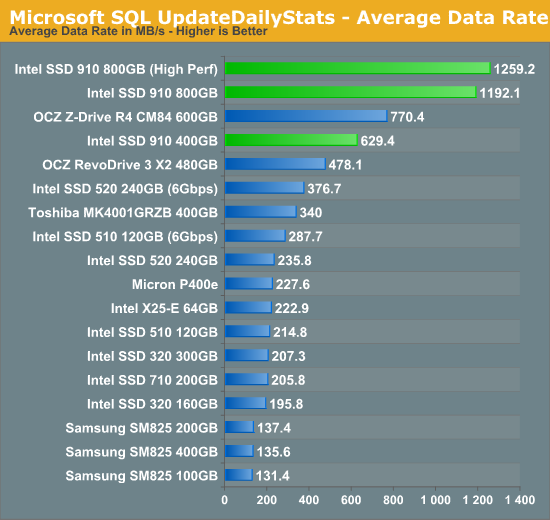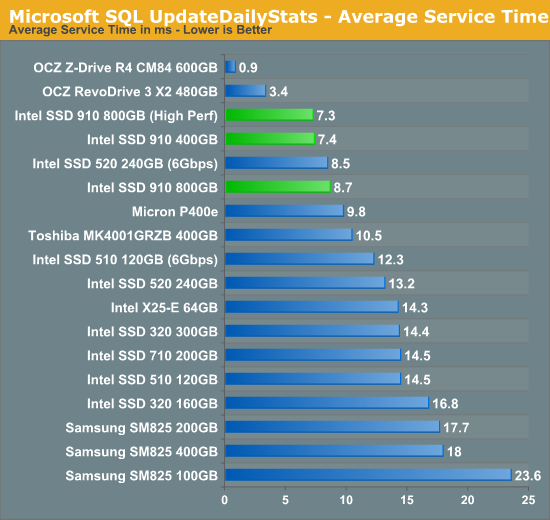The Intel SSD 910 Review
by Anand Lal Shimpi on August 9, 2012 1:00 PM EST- Posted in
- Storage
- SSDs
- Intel
- Intel SSD 910
Enterprise Storage Bench - Microsoft SQL UpdateDailyStats
Our next two tests are taken from our own internal infrastructure. We do a lot of statistics tracking at AnandTech - we record traffic data to all articles as well as aggregate traffic for the entire site (including forums) on a daily basis. We also keep track of a running total of traffic for the month. Our first benchmark is a trace of the MS SQL process that does all of the daily and monthly stats processing for the site. We run this process once a day as it puts a fairly high load on our DB server. Then again, we don't have a beefy SSD array in there yet :)
The UpdateDailyStats procedure is mostly reads (3:1 ratio of GB reads to writes) with 431K read operations and 179K write ops. Average queue depth is 4.2 and only 34% of all IOs are issued at a queue depth of 1. The transfer size breakdown is as follows:
| AnandTech Enterprise Storage Bench MS SQL UpdateDaily Stats IO Breakdown | ||||
| IO Size | % of Total | |||
| 8KB | 21% | |||
| 64KB | 35% | |||
| 128KB | 35% | |||

Our SQL benchmarks are far more compatible with the 910 in terms of IO size, as a result Intel posts the absolute best scores we've seen yet here. The 400GB drive cuts performance in half compared to the 800GB model, but you're still looking at 3x the performance from a 200GB Intel SSD 710. Toshiba's 400GB drive does very well, but Intel's SSD 520 ends up being the fastest 2.5" drive here.












39 Comments
View All Comments
JellyRoll - Friday, August 10, 2012 - link
WOW. low QD testing on an enterprise PCIe storage card is ridiculous. End users of these SSDs will use them in datacenters, and the average QD will be ridiculously high. This evaluation shows absolutely nothing that will be encountered in this type of SSDs actual usage. No administrator in their right mind would purchase these for such ridiculously low workloads.SanX - Friday, August 10, 2012 - link
and you do not need more then 16/32/64GB size for your speedy needs, then consider almost free RAMdisk with the backup. It will be 4-8x faster then this cardmarcplante - Friday, August 10, 2012 - link
It seems that there would be a market for a consumer desktop implementation.Ksman - Friday, August 10, 2012 - link
Given how well the 520's perform, perhaps a RAID with 520's on a LSI RAID adapter would be a very good solution and a comparison VS the 910 would be interesting. If RAID>0, then one could pull drives and attach direct for TRIM etc which would eliminate the problem where SSD's in a RAID cannot be managed.Pixelpusher6 - Friday, August 10, 2012 - link
I was wondering the exact same thing. What are the advantages of offering a PCIe solution like this compared to say just throwing in a SAS RAID card and connecting a bunch of SSD SAS drives in a RAID 0? Is the Intel 910 mainly targeted at 1U/2U servers that might not have space available for a 2.5" drive? Is it possible to over-provision any 2.5" drive to increase endurance and reduce write amplification (I think the desktop Samsung 830 I have allows this)? Seeing the performance charts I wonder how 2 of those Toshiba 400GB SAS drives would compare against the Intel 910.Is the enterprise market moving towards MLC-HET NAND with tons of spare area vs. SLC NAND because of the low cost of MLC NAND now since fabs have ramped up production? I was under the impression that SLC NAND was preferable in the enterprise segment but I might be wrong. What are some usage scenarios where SLC would be better than MLC-HET and vice versa?
I think lorribot brought up a good point:
"I like the idea but coming from a highly redundant arrays point of view how do you set this all up in a a safe and secure way, what are the points of failure? what happens if you lose the bridge chip, is all your data dead and buried?"
I wonder if it is possible to just swap the 1st PCIe PCB board with all the controllers and DRAM in case of a failure of the bridge chip or controller thus the data remains safe. Can SSD controllers fail? Is it likely that the Intel 910 will be used in RAID 0? I didn't think RAID 0 was used much in enterprise. Sorry for all the questions. I have been visiting this site for over 10 years and I just now registered an account.
FunBunny2 - Saturday, August 11, 2012 - link
eMLC/MLC-HET/foo-MLC are all attempts to get cheaper parts into SSD chassis, even for enterprise companies such as Texas Memory. Part of the motivation is yet more sophisticated controllers, and, I suspect, the realization that enterprises understand duty life far better than consumers (who'll run a HDD forever if it survives infant mortality). The SSD survival curve (due to NAND failure) is more predictable than HDD, so with the very much faster operations, if 5 years remains the lifetime, the parts used don't matter. The part gets swapped out at 90% or 95% of duty life (or whatever %-age the shop decides); end of story. 5 years ago, SLC was the only way to 5 years. That's not true any longer.GatoRat - Sunday, August 12, 2012 - link
"the 800GB 910 is easily the fastest SSD we've ever tested."Yet the tests clearly show that it isn't. In fact, the Oracle tests show it's a dog. In other tests, it doesn't come up on top. The OCZ Z-Drive R4 CM84 600GB is clearly the faster overall drive.
Galcobar - Sunday, August 12, 2012 - link
Grok!I'm impressed both to see the literary reference, correctly used, and that nobody has called it a typo in the comments. Not bad for a fifty-year-old novel once dismissed by the New York Times as a puerile mishmash.
a50505 - Thursday, August 30, 2012 - link
So, has anyone heard of a workstation class laptop that with a PCIe based ssd?